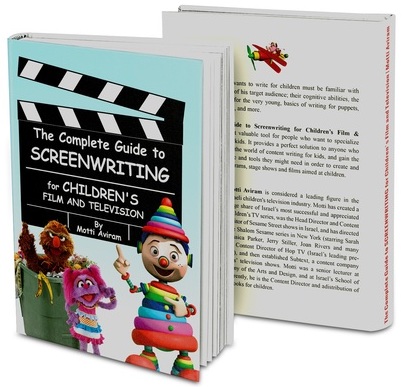Click on the image below – to see the book on Amazon !
Why Write for Kids?
Because in writing for kids you can still make a difference!
Writing for children enables you to provide them with information and experiences that they’ll never forget.
A scriptwriter who wants to write for children must be familiar with the wants and needs of his target audience; their cognitive abilities, the principles of humor for the very young, basics of writing for puppets, animation techniques, and more.
The Complete Guide to Screenwriting for Children’s Film & Television, is a most valuable tool for people who want to specialize in script writing for kids. It provides a perfect solution to anyone who wants to succeed in the world of content writing for kids, and gain the necessary knowledge and tools they might need in order to create and write television programs, stage shows and films aimed at children.
The book includes such topics as:
- Understanding the cognitive abilities of young viewers, their psychological needs, and their behavioral patterns.
- Principles of script writing, while focusing on script writing for children. This book introduces the reader to a series of techniques from the world of children’s literature, such as: rhyming, accumulation, repetition, rhythmic patterns… techniques that significantly increase children’s joy in the texts to which they are exposed via the screen.
- Children’s humor. The book discusses the principles of humor in general, and in children’s comedy in particular. It follows the development of humor among children, from the basic nonsense humor, to sophisticated words games. It explores children’s attraction to crude jokes, and to the forbidden humor (shit & pee jokes) so beloved by children. It explains what comic characters are, what comic situations kids love, and what is considered to be a good comic text for a child.
- Creative skills. The book also deals with the creative skills needed in order to write for children. It introduces its readers to all the fantastic worlds of content that children are excited about, such as: hidden tiny dwarves, wondrous flying horses, faeries, princesses, monsters, super-heroes, and more.
- Puppets in children’s TV shows & movies. This book provides its readers with the essential knowledge in the field of incorporation puppets into children’s TV shows or movies. It exposes the reader to the various “types” of puppets, and the differences between various puppets manners of expression. It equips the reader with the principles of shooting puppets (as opposed to shooting live actors), and all the operative principles of TV shows and movie sets where puppets are involved.
- Animation. The book also examines the advantages (or disadvantages) of animation genres as opposed to other productions intended for children. And focuses on techniques of writing for animated characters in animated worlds. The book also reviews the various production techniques used in: two-dimension animation (classic animation), three-dimensions (computer-generated), cut-outs, and also techniques initially developed for the internet, which are now also used on television.
- Finally, the book enables its readers to assess their suitability for the world of children’s writing, understand what is expected from children’s content creators, and learn how to keep up-to-date with these worlds of contents.


